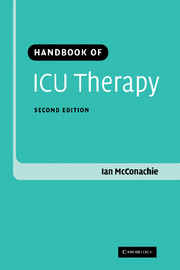Book contents
- Frontmatter
- Contents
- List of contributors
- Preface
- Part I Basic principles
- Part II Specific problems
- 17 The surgical patient in the ICU
- 18 The trauma patient
- 19 Acute coronary syndromes
- 20 Heart failure
- 21 Arrhythmias
- 22 The patient with sepsis
- 23 Acute renal failure in the critically ill
- 24 Acute lung injury and ARDS
- 25 The patient with gastrointestinal problems
- 26 The comatose patient
- 27 The critically ill asthmatic
- 28 The critically ill diabetic
- 29 The cardiac surgical patient in the ICU
- 30 Cardiac arrest
- Index
17 - The surgical patient in the ICU
Published online by Cambridge University Press: 24 August 2009
- Frontmatter
- Contents
- List of contributors
- Preface
- Part I Basic principles
- Part II Specific problems
- 17 The surgical patient in the ICU
- 18 The trauma patient
- 19 Acute coronary syndromes
- 20 Heart failure
- 21 Arrhythmias
- 22 The patient with sepsis
- 23 Acute renal failure in the critically ill
- 24 Acute lung injury and ARDS
- 25 The patient with gastrointestinal problems
- 26 The comatose patient
- 27 The critically ill asthmatic
- 28 The critically ill diabetic
- 29 The cardiac surgical patient in the ICU
- 30 Cardiac arrest
- Index
Summary
This chapter brings together many aspects of relevance to “high-risk” surgical patients admitted to the intensive care unit (ICU).
For a full discussion of
aspects of risk assessment,
anaesthetic and surgical risk factors,
cardiac risk, scoring systems and investigations,
respiratory risk and the role of pulmonary function testing.
the reader is recommended to consult Anaesthesia for the High Risk Patient by the same author and publisher.
Preoperative assessment
The aim of preoperative assessment is to minimise morbidity and mortality.
Three questions should be asked when assessing surgical patients with the aim of minimising operative risk:
Is the patient's medical and physiological status optimum?
If not, can the patient's status be improved (time permitting)?
If not, should the operation still proceed? In other words, do the risks of not operating outweigh the risks of operating? For example, medical status is almost irrelevant if the operation is clearly life saving. Thus, no patient is “not fit” for surgery — it just depends on the urgency of the situation. However, the patient should be considered salvageable by surgery. If not, palliative care may be more appropriate than heroic interventions.
Preoperative assessment should identify those patients who are at high risk of per-or postoperative organ failures. Such patients may need additional monitoring and may warrant admission to ICU or a high-dependency unit (HDU) postoperatively for organ function monitoring or support.
- Type
- Chapter
- Information
- Handbook of ICU Therapy , pp. 225 - 247Publisher: Cambridge University PressPrint publication year: 2006



